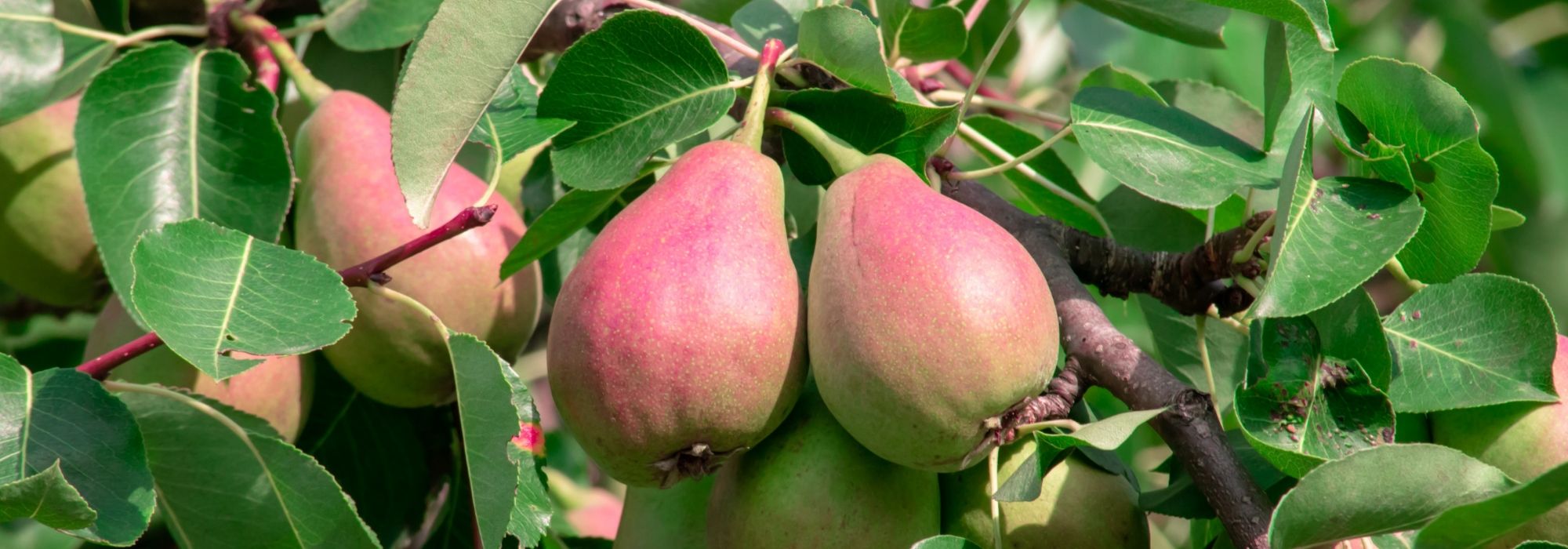
Pear tree: planting, pruning and care
Contents
Pear tree, in a nutshell
- Pear tree is a very popular fruit tree, prized for its pears with tasty, melting flesh.
- Prefers temperate climates that are neither too dry nor too cold because of early flowering, and a sunny position.
- Plant them preferably in heavy, clay-rich, fertile, cool but well-drained soil, avoiding soils that are too acidic or too calcareous (risk of chlorosis).
- Pear tree usually needs another pollinating variety to set fruit. In humid climates, choose varieties resistant to scab.
A word from our expert
Pear trees are among the most widely grown fruit trees in France alongside apple trees as they adapt to a wide range of French regions. The flavour of fruit with melting flesh when picked at ripeness on the tree is inimitable. Unfortunately, ripe fruit is quite sensitive to bruising, which explains why pears are often sold still green and firm, especially since they keep longer when picked before ripeness.
Pear trees take many forms, from a rigid spindle to a spreading weeping habit as with the ‘Williams’ variety, not to mention the different training systems used on this fruit tree, ranging from the open‑grown tree to palmette, double U and fan…
Like apple trees, some varieties perform better in certain regions, such as ‘Conférence’ which favours cool, damp areas, and ‘Alexandrine’ which prefers the Midi. Others are very adaptable, like ‘Louise‑Bonne d’Avranches’. In all cases, a second variety flowering at the same time is preferable to achieve good pollination, even with varieties described as self‑fertile. A drawback of many pear trees is that their relatively early flowering can be wiped out by a late frost.
Pruning of pear trees is very similar to that of apple trees because they bear fruit on 1‑ to 3‑year‑old wood. Pruning is almost non‑existent on spindle forms, which also have the advantage of occupying little ground space and can even be grown on a terrace or balcony, like dwarf varieties.
Description and botany
Botanical data
- Latin name Pyrus communis
- Family Rosaceae
- Common name Common pear
- Flowering between March and April
- Height between 1 and 15 m
- Exposure sun
- Soil type any loose, fresh, well-drained soil, without excess lime
- Hardiness Good (-20 °C)
Genus Pyrus includes 65 species distributed across a wide territory from temperate Eurasia to North Africa and belongs to the family Rosaceae. Common pear (Pyrus communis) is a fruit tree native to Central Asia, domesticated in China for more than 6,000 years for the flavour of its pears. Introduced into Europe around the 6th century, the pear has given rise to a multitude of varieties, which were already propagated by grafting in Roman times. Although its development in the Middle Ages remained limited, nearly 200 varieties existed by the Renaissance. Since then, the number of varieties has continued to increase. It is now grown across all regions of France below 1000 m altitude, benefiting from a temperate climate.
The pear has good longevity, hard wood and fairly slow growth in its natural habitat. The wild form can reach 12–15 m in height while cultivated forms measure 3–5 m. Habit varies with variety, from a spindle with short shoots to a wide, spreading or even trailing habit. Its brown to dark grey bark cracks in a pattern of squares.
Leaves are alternate, single, dark green and glossy with a glabrous pale green underside, which helps to distinguish it from the apple tree whose lower surface is villous. They are borne on a slender petiole almost as long as the lamina, which causes a rustle at the slightest breeze. Leaves take on a beautiful golden-yellow autumn colouring often with orange-red shades.
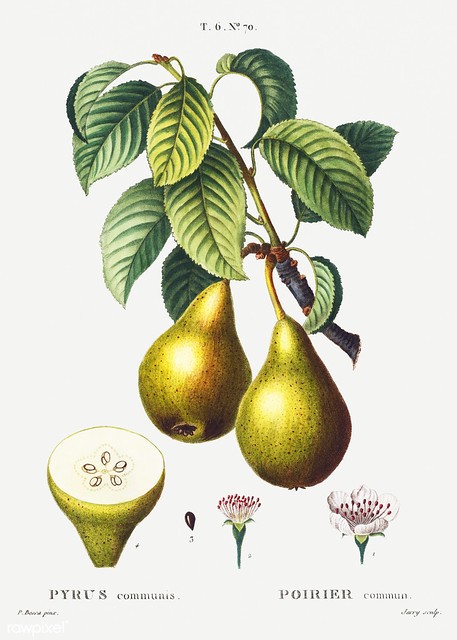
Pyrus communis – botanical illustration by PJ Redouté
Nashi (Pyrus pyrifolia) is an East Asian species with almost round fruits that resemble an apple, hence the name apple-pear. Also called Asian pear or Japanese pear, its flesh is very crisp and juicy, keeps poorly and is eaten raw after removing the bronze skin speckled with cream. The species was introduced and cultivated in France only from the 1980s, especially in the South-West, since the tree tolerates only frosts down to about -15 °C. Not self-fertile, this species can be pollinated by common pear, with the variety Williams reputed to be a very good pollinator for most pears.
There are pear trees with small astringent fruits grown solely for ornamental use, such as Pyrus calleryana ‘Chanticleer’. This species is distinguished by its narrow conical habit, spiny branches, abundant flowering and especially a very attractive red to magenta autumn colouring, which explains its frequent use along roads and avenues. Another species, Pyrus salicifolia ‘Pendula’ (willow-leaved pear), offers elongated silvery foliage reminiscent of the olive and a weeping habit, reaching 5–6 m in height with a 4 m spread. It makes a very fine specimen tree, with the advantage of tolerating dry soils, sea spray and cold.
Pear flowering appears as clusters of white flowers about 3 cm in diameter, before leafing, fairly early in spring in March–April. They attract many bumblebees and bees that assist with pollination as few varieties are self-fertile. The variety Williams is known as a good pollinator for most varieties. Flowers consist of 5 green sepals and 5 white or pinkish petals with a centre of red stamens surrounding the pistil. Pear can be subject to alternate bearing (a good year followed by a poor one); in such cases, thinning of young fruit after the June drop helps to remedy the problem.
Pears are pome fruits containing pips and present various shapes — elongated, conical, swollen or cylindrical, with the fruit base widening and bearing the remains of sepals and stamens at its top. As with the apple, this is a pseudocarp (pome) formed from the swelling of the flower receptacle that encloses the carpel containing the seeds (core). In the smallest varieties close to the wild pear, the fruit measures about 5 cm long, while the largest can weigh up to 700 g, as with ‘Beurré Clairgeau’. The epidermis is green and turns yellow, sometimes flushed with pink, red or bronze at ripeness, sometimes showing grey speckling. Old varieties bearing the name Beurré, such as ‘Beurré Hardy’, have particularly melting flesh, especially when picked just before ripeness. Others have a grainy, so-called gritty texture due to the presence of very thick-walled cells, the sclereids. Pears with a musky flavour such as ‘Bon Chrétien’ are the origin of ‘Williams’, also called ‘Williams Bon Chrétien’ or ‘Bartlett’, for which a red-skinned form called ‘Red Bartlett’ exists. Some pears, like ‘Conference’, should be picked about 15 days before full ripeness, at the end of September–early October, to benefit from long storage until January. Eating quality depends greatly on growing conditions, so it is important to check whether a variety is well suited to your region. Constraints of the site can, however, be overcome by choosing a suitable rootstock, bearing in mind that nursery pear plants are always grafted. Rootstock also influences plant vigour, which allows certain training systems such as an open-grown standard grafted on a pear seedling rootstock or an espalier grafted on a quince rootstock.
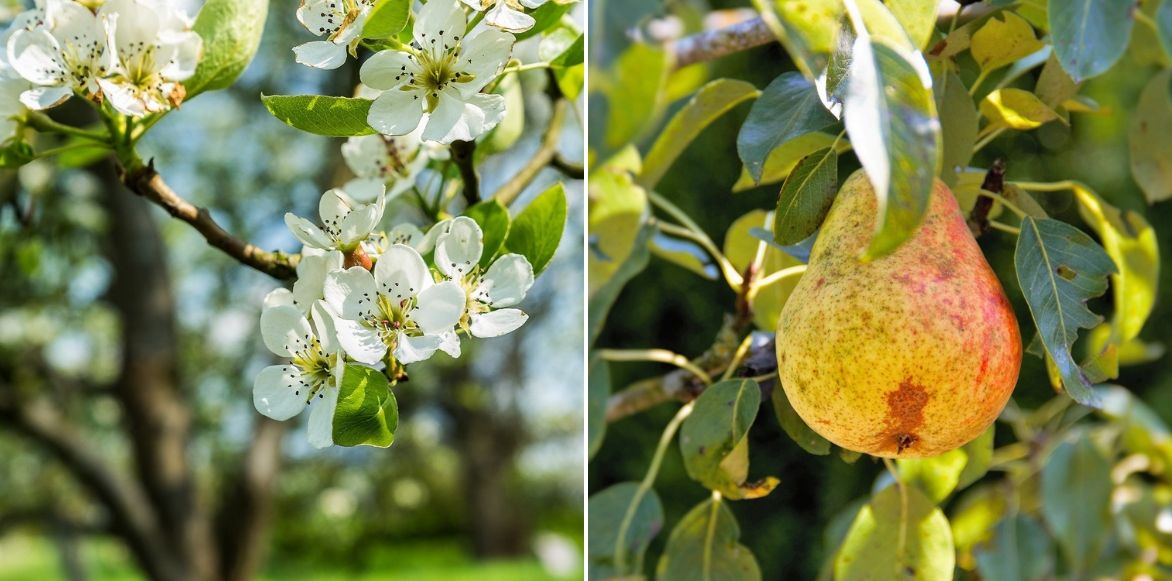
Pyrus communis : flowers and fruits
Read also
Fruit trees: pruning of a young shootMain pear varieties
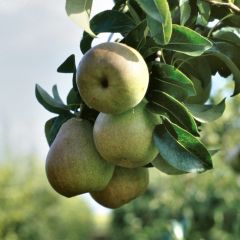
Pyrus communis Beurre Hardy - Pear Tree
- Flowering time May
- Height at maturity 4,50 m

Pyrus communis Delbardèlice - Pear Tree
- Flowering time May
- Height at maturity 5 m
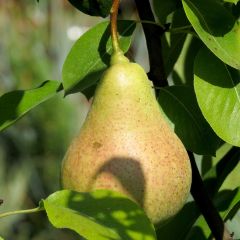
Pyrus communis Williams Bon Chrétien Pear Tree
- Flowering time May
- Height at maturity 6 m
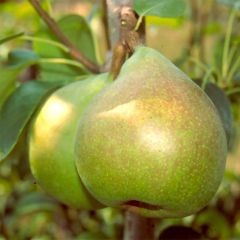
Pyrus communis Doyenné du Comice - Pear Tree
- Flowering time May
- Height at maturity 7 m
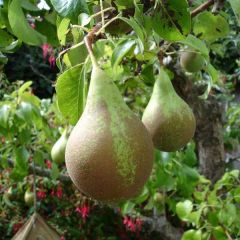
Pyrus communis Conférence - Pear Tree
- Flowering time April, May
- Height at maturity 6 m
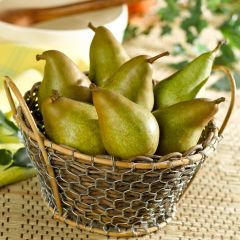
Pyrus communis Delbard Gourmande - Pear Tree
- Flowering time May
- Height at maturity 5 m
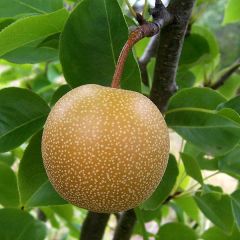
Nashi Shinseiki - Apple-Pear
- Flowering time April, May
- Height at maturity 4,50 m
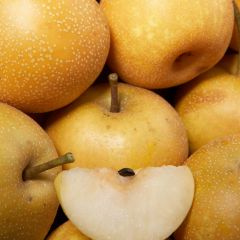
Nashi Hosui Abundance - Apple-Pear
- Flowering time May
- Height at maturity 5 m
Discover other Pear trees
View all →Available in 1 sizes
Available in 1 sizes
Available in 1 sizes
Available in 1 sizes
Available in 1 sizes
Available in 0 sizes
Available in 0 sizes
Available in 1 sizes
Available in 0 sizes
Planting
Where to plant pear trees?
Le pear tree is planted in orchard or garden, as a free-standing tree or espaliered on a support. Choose a south-east or south-west aspect.
Needing warmth, plant in shelter from prevailing winds, especially north of the Loire. Pear tree prefers cool, rich soils, but dislikes soils that are too dry or too calcareous. Some varieties such as Garden Gem® or Garden Pearl® have dwarf habit, allowing them to be grown in ground or in a pot in small spaces.
As with Apple tree, pear tree requires another variety nearby (pollinator) to ensure good fruit set. Williams has an extended flowering period, allowing it to pollinate most varieties as well as nashi species.

Nashi (Pyrus pyrifolia)
When to plant?
Pear trees sold as bare roots are ideally planted between October and March, outside frost periods. Trees offered in containers can be planted all year round except during periods of extreme heat or frost, provided watering is monitored.
How to plant?
If your pear tree is in a container:
- Immerse pot in a bucket of water to thoroughly moisten it.
- Loosen soil deeply, remove stones and unwanted weeds.
- Add some gravel to improve drainage if necessary.
- Dig a wide planting hole at least three times the volume of the rootball. Make sure to place subsoil to one side and topsoil to the other side.
- Mix horn meal (rich in nitrogen), a base fertiliser (rich in phosphorus and potassium) and organic matter (potting soil, compost…) with the subsoil and place this mixture at the bottom of the planting hole.
- Place the rootball, cover with topsoil without burying the graft union and firm down. Water generously (around 10 litres).
- It can be useful to stake the pear tree by installing a guying system: place three stakes in a triangle 50 cm from the trunk and connect them with pieces of wood. Protect the bark with a piece of rubber for example and tie the stakes to the trunk with wire.
If your pear tree is bare-root:
- Start by preparing a pralin made of 1/3 very fine soil or potting soil, 1/3 cow dung or compost and 1/3 rainwater. If you live in town and cow dung is scarce, pralin is also available commercially.
- Prune roots if necessary to obtain clean cuts,
- Dip roots in the pralin to prevent air pockets forming between roots and soil.
It is also possible to espalier pear tree on a support (U-shaped palmette or Verrier palmette for example):
- Install a sturdy espalier and staking framework before planting: end posts fitted with struts and intermediate posts,
- Run lengths of wire,
- Tie shoots intended to form the main framework with soft ties.
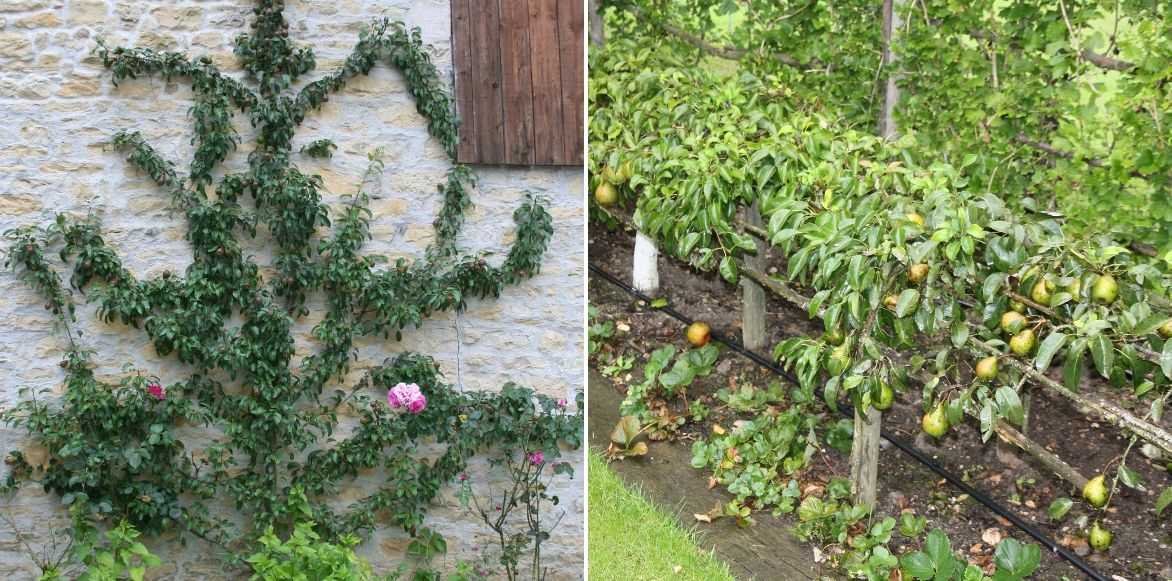
Espaliered pear trees against a wall and in cordons
Pruning, care, possible diseases
- Every year in autumn, spread well-rotted compost on the surface. Then in winter, add a small shovel of wood ash, rich in potash, to improve fruiting.
- Hoe at the base of the tree to remove weeds, especially at the drip line of the crown where the absorbent roots are located.
- Water regularly, depending on climate, for the first two or three years.
- In June, when pears are set, carry out thinning: keep only 1 to 2 fruits per cluster, favouring pears situated on the periphery. Your pears will then reach a larger size. Learn more in our tutorial Why and how to thin fruit trees?
Potential diseases and pests
The pear tree may be susceptible to various diseases and pests. Fire blight has caused serious damage in France in the past, so the most susceptible varieties are banned from planting, which does not prevent remaining vigilant if you observe sudden dieback of certain branches, notably after flowering.
Against scab (brown spots on leaves), brown rot (flower dieback and fruit rot on the tree) and powdery mildew (white felt on the leaves), spray Bordeaux mixture and/or horsetail decoctions as a preventative measure.
On the pest side, the codling moth or fruit worm, a small caterpillar, can be controlled by installing bird and bat boxes, placing corrugated-cardboard strips along the trunk and bagging fruit in brown kraft paper. In case of an aphid attack, spray a mixture of water and black soap.
Cephus attacks can be alarming because of the number of pear shoots whose tips suddenly blacken and curl into a crozier in May–June. The egg-laying of this small wasp has little impact on the life of the tree but alters the harmonious development of new shoots. Eggs hatch once the tip has blackened, then the larvae bore a tunnel until the following spring in the underlying part. Cut these shoots 10 cm below the dried area before burning them or leave them for starlings and other insectivorous birds that relish these larvae.
→ Learn more about pear tree diseases and pests in our advice sheet!
Pear tree pruning
The pear tree is a pip-bearing fruit tree that can be pruned in the same way as the apple tree. Espalier-trained forms are the most demanding in pruning to maintain the training structure, whether double U, palmette or cordon. Prune in December–January, before apples are pruned as they flower later, and apply trigemme pruning, which consists of leaving 3 buds on each wood shoot to turn them into coursonnes (fruiting spurs). However, trees purchased already trained already show buds (large rounded buds) which simply need to be retained in sufficient number during pruning. Pinching in July completes winter pruning and corrects mistakes: leave 7 leaves after a fruit and remove non-fruit-bearing shoots to allow sunlight to colour the fruit.
Natural spindle forms or very trailing types such as the variety Williams do not need pruning to improve fruiting.
For other cases, don’t panic: you can limit interventions to every 2 or 3 years to carry out the following operations between November and March:
- Remove, if necessary, suckers that have grown at the base of the tree and water shoots developing on the trunk.
- Remove dead or broken branches, as well as those that cross each other.
- Cut small twigs and some branches growing towards the inside of the crown to allow air and light to circulate.
- Prune branch ends above a bud facing outwards.
→ Also discover our advice sheet on alternate bearing in fruit trees and how to recognise the different buds and shoots of fruit trees for successful pruning.
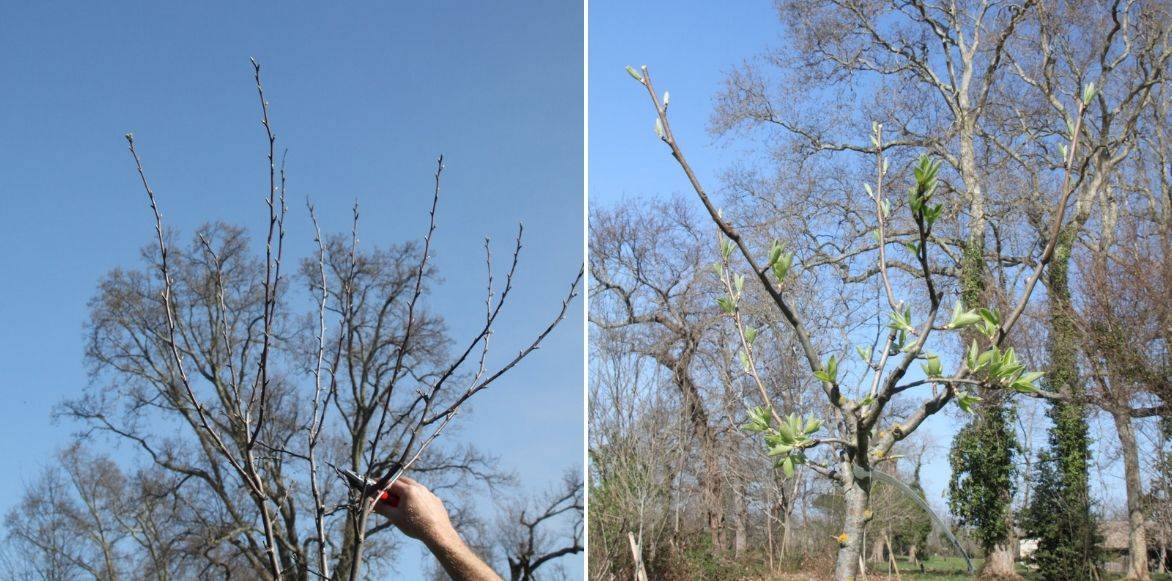
Pear tree pruning
→ Learn more about the harvest and storage of apples and pears in our advice sheet
Propagation
Most commonly used propagation method for pear trees is grafting onto a rootstock produced by sowing, such as a pear seedling or quince. This method remains the preserve of experienced gardeners or professionals.
Sowing pear pips
- Remove pips from a ripe pear, wash them under cold water and dry them in a tea towel.
- Leave them to dry for 2-3 days below 15°C, turning occasionally.
- Then stratify the pips in a pot by placing them between two layers of moistened sand for 3 months.
Uses and associations
Pear trees make excellent specimens when grown individually as they appreciate good sun. Space them at a distance equal to the height of the mature tree. You can train them as espaliered fruit hedges using wire, spaced at the height of the hedge, oriented north-south.
You can also insert them into a mixed, informal hedge made up of a combination of fruit trees such as apple trees and deciduous bushes, avoiding shade from a large tree.
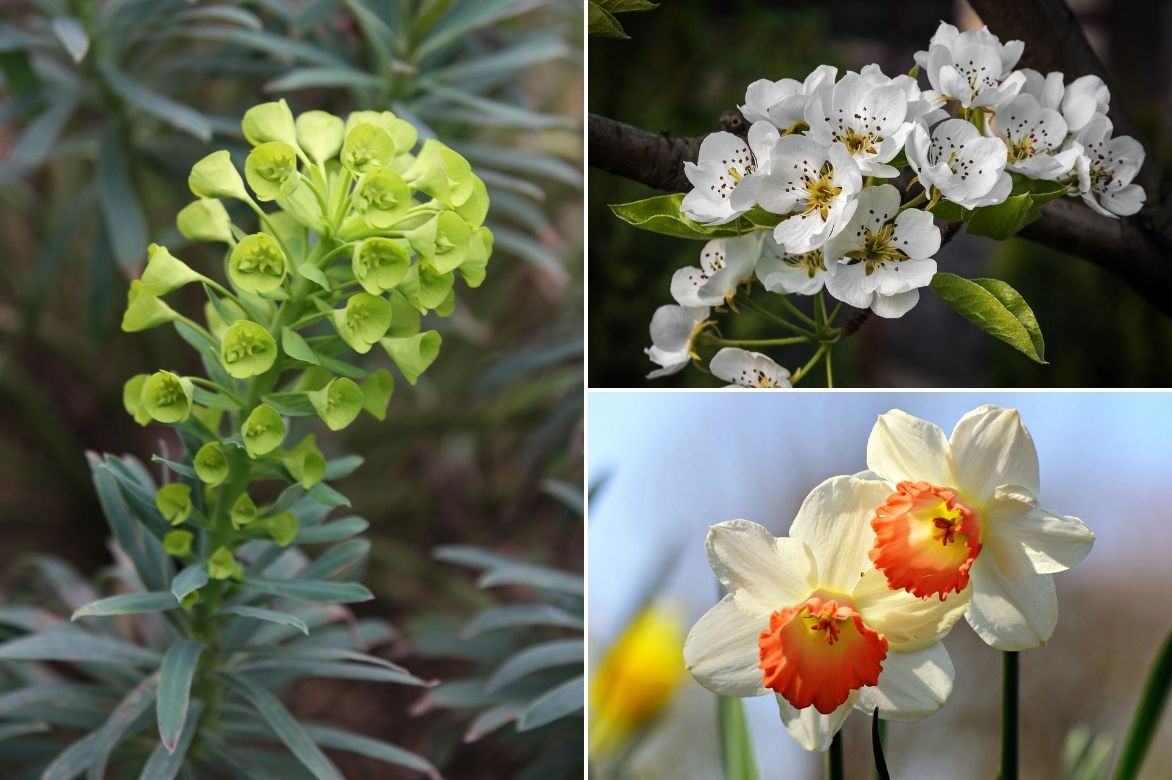
A spring pairing idea: Euphorbia characias ssp wulfenii, Pyrus communis and narcissi
Create a large planting with the pear tree surrounded by shade plants such as peppermint which serves as groundcover or blueberries.
An interesting experiment showed that scarlet runner beans (Phaseolus coccineus) could be grown up frames placed all around the crown of a pear tree. This association reportedly helped protect pears from codling moth, aphids and predatory, sugar-seeking wasps late in summer. Harvest of the beans was also greater than on isolated frames. The large melliferous flowers of the beans likely helped attract beneficial fauna.
Dwarf pear trees Garden Pearl or Garden Gem work well on a terrace alongside vegetable beds and small fruit.
To learn more
Discover:
- Our range of Pear trees: over 30 varieties sold online
- Advice sheet: Pear tree: best varieties
- Advice sheet: What is a rootstock and which to choose?
- Advice sheet: Pruning fruit trees in palmate form
- Advice sheet: Fruit trees: most popular self-fertile varieties
- Advice sheet: Which fruit trees and bushes to plant in clay soil?
- Discover how to choose your pear tree? Our buying guide
- Discover the 7 best pears for long-term storage
- Pear trees: why choose old and local varieties?
- Gwenaëlle tells you the origins and history of the pear in : Where do our fruit trees come from?
- Subscribe!
- Contents
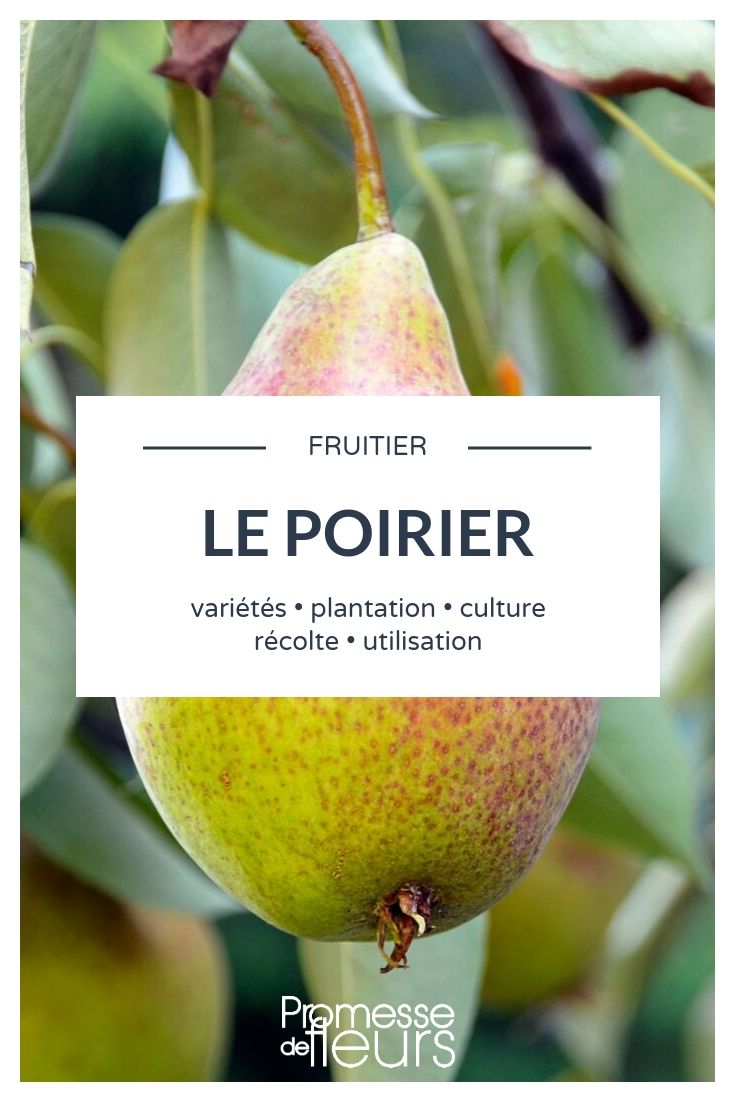


































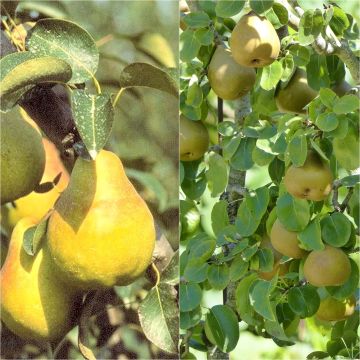
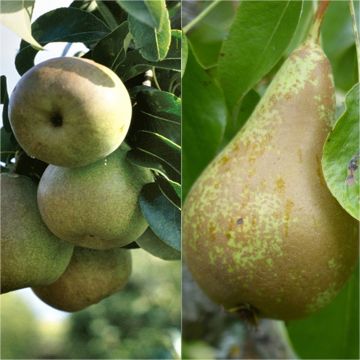
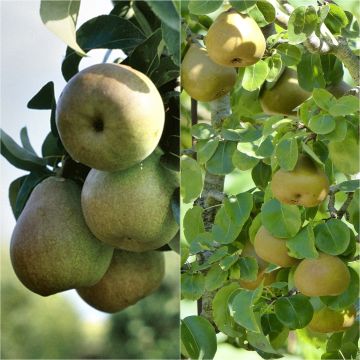
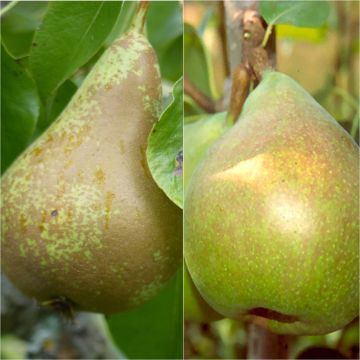
Comments